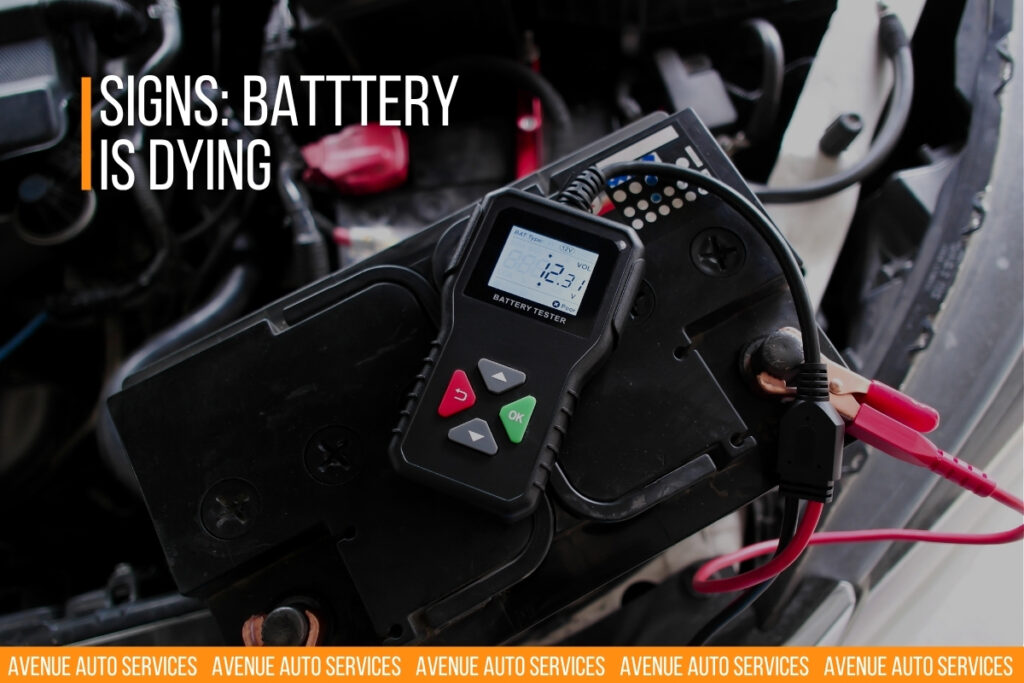Your car battery is often the unsung hero of your vehicle. It powers everything from starting the engine to running your headlights, infotainment system, AC, and even advanced safety features. Without it, your car is just a piece of metal that won’t move an inch.
Yet, many car owners overlook the early signs battery is dying until one day, their car refuses to start. Being stranded on the road, especially in a busy city like Dubai or Sharjah, can be stressful and even dangerous. The good news? Batteries don’t usually fail overnight. They give you plenty of warning signs before they completely die.
In this detailed guide, we’ll walk you through the 10 most common signs your car battery is dying and needs replacement, why they happen, and what you can do about it.
1. Slow Engine Crank – The First Red Flag
When you start your car, the battery sends power to the starter motor, which cranks the engine. If your engine sounds sluggish, taking longer to turn over before it starts, that’s one of the earliest signs battery is dying.
-
Why it happens: Weak battery charge can’t deliver enough current to the starter motor.
-
Example: You turn the key and instead of the usual quick ignition, the engine struggles and drags.
-
Solution: Get the battery voltage tested. Anything below 12.4 volts indicates weakness.
2. Dim Headlights and Flickering Interior Lights
Your battery doesn’t just start the car; it also powers the lights. If your headlights are dimmer than usual or your dashboard lights flicker when idling, it’s a clear indication.
-
Why it happens: A dying battery can’t maintain steady voltage, causing lights to fluctuate.
-
Example: You notice your headlights brighten slightly when revving the engine, then fade when idle.
-
Solution: Test the alternator as well, since dimming could be related to charging issues.
This is one of the most noticeable signs battery is dying and shouldn’t be ignored especially for night driving safety.
3. Electrical Failures and Malfunctions
Modern vehicles are loaded with electronics: power windows, infotainment screens, automatic seat adjusters, and navigation systems. If these features start acting up, it might not be a glitch it could be your battery.
-
Why it happens: Insufficient power supply disrupts normal functioning of accessories.
-
Example: Power windows move slower, the radio cuts off randomly, or AC vents don’t blow properly.
-
Solution: Check the battery terminals for corrosion as well, since dirty connections can mimic dying battery symptoms.
4. Clicking Noise When Starting
When you attempt to start your car and hear nothing but a rapid clicking sound, your battery is too weak to power the starter.
-
Why it happens: Low charge prevents the solenoid from engaging properly.
-
Example: You turn the ignition, but instead of the engine, you hear a “tick-tick-tick.”
-
Solution: You might need a jump-start immediately, but consider this a short-term fix.
This is one of the unmistakable signs battery is dying—by this stage, replacement is usually necessary.
5. Frequent Jump Starts
Needing a jump-start once every few years is normal. But if you’ve had to do it several times in a month, your battery is failing.
-
Why it happens: The battery no longer holds a charge.
-
Example: You jump-start your car in the morning, but by evening, it won’t start again.
-
Solution: Replace the battery. Repeated jump-starts can also damage other electrical parts like the alternator.
6. Battery Warning Light on Dashboard
Most cars have a dedicated battery warning light shaped like a rectangle with plus and minus symbols.
-
Why it happens: Low voltage, alternator issues, or bad wiring.
-
Example: The light appears when you turn the key and stays on after the engine starts.
-
Solution: Don’t ignore this light. Combine it with other signs battery is dying to confirm the problem.
7. Swollen or Leaking Battery Case
A healthy battery looks clean and solid. A swollen, cracked, or leaking battery case is dangerous.
-
Why it happens: Overheating, extreme weather, or overcharging causes expansion and acid leaks.
-
Example: You pop the hood and notice the battery looks bloated or has wet spots around it.
-
Solution: Replace immediately. Leaking acid can corrode cables and even damage engine components.
8. Rotten Egg Smell Around the Car
A strong sulfur or rotten egg smell under the hood indicates your battery is leaking.
-
Why it happens: A dying battery releases hydrogen sulfide gas.
-
Example: You smell something foul when the hood is open, especially after driving.
-
Solution: Replace the battery and have the area cleaned, as acid leaks can corrode metal parts.
This is not only one of the clearest signs battery is dying but also a serious safety hazard.
9. Old Battery Age – Beyond Its Lifespan
Car batteries don’t last forever. On average, they serve 3-5 years, depending on climate, driving habits, and maintenance.
-
Why it happens: Over time, the internal plates corrode, reducing charge capacity.
-
Example: Your car runs fine, but your battery is over 4 years old it’s living on borrowed time.
-
Solution: Proactively replace old batteries before they fail, especially before long trips.
10. Hard Starts in Cold Weather
Cold weather reduces a battery’s ability to hold and deliver power. If your car struggles to start on chilly mornings, your battery might be weak.
-
Why it happens: Cold slows chemical reactions inside the battery.
-
Example: The engine cranks very slowly or not at all on cold mornings.
-
Solution: If your battery is older than 3 years and struggles in winter, replace it.
Why Ignoring These Signs Is Risky
Driving with a weak battery isn’t just inconvenient it’s risky. A failing battery can:
-
Leave you stranded at the worst time.
-
Put extra strain on the alternator.
-
Cause electrical issues that damage other systems.
-
Lead to expensive repairs if acid leakage corrodes engine parts.
Paying attention to the signs battery is dying allows you to plan replacement rather than face an emergency.
How to Confirm If Your Battery Is Dying
Before replacing, have your battery tested. A simple voltage test with a multimeter can reveal its health:
-
12.6V or higher = fully charged
-
12.4V = partially charged
-
12.0V = weak, needs attention
-
11.9V or lower = failing, replace immediately
Many auto repair centers offer free battery testing take advantage of it if you’re noticing the warning signs.
Final Thoughts
Your car battery may be small, but it’s vital for your vehicle’s performance and reliability. Recognizing the signs battery is dying from slow starts and dim lights to foul smells and frequent jump starts can save you from sudden breakdowns.
If you notice two or more of these symptoms, don’t delay. Have your battery inspected and replaced at a trusted auto service center. Regular maintenance ensures peace of mind, smooth starts, and safe drives every time you hit the road.
If you’ve noticed signs like swelling, corrosion, or a foul smell around your battery, these could be more than just symptoms they could indicate a leaking battery issue. For a thorough breakdown of what causes battery leakage, how it damages your vehicle, and when to act, check out our full guide on Why Your Car Battery Is Leaking at Avenue Auto Services.




